Venezuelan Cuisine
This article relates to It Would Be Night in Caracas

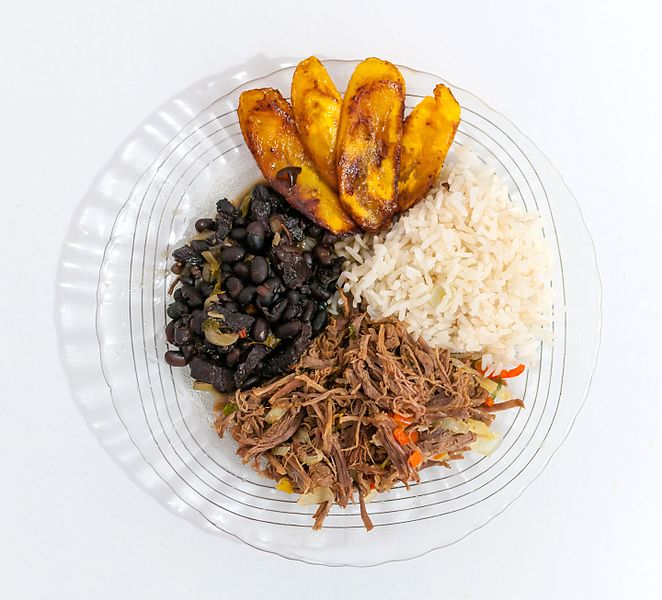 In the novel It Would Be Night in Caracas, protagonist Adelaida endures food scarcity in Venezuela's capital city, Caracas, while recalling favorite foods from happier times. Venezuela—situated along the Caribbean Sea in South America —is home to a vibrant blend of culinary traditions. The country's cuisine has European, African, and indigenous influences that make it irresistible. As with much of Latin America, maize (corn) is a staple of the country. Other popular local crops include plantains, coconut, avocado, mango, guava, citrus, and passion fruit. A few of the nation's most prominent ingredients and dishes include the following:
In the novel It Would Be Night in Caracas, protagonist Adelaida endures food scarcity in Venezuela's capital city, Caracas, while recalling favorite foods from happier times. Venezuela—situated along the Caribbean Sea in South America —is home to a vibrant blend of culinary traditions. The country's cuisine has European, African, and indigenous influences that make it irresistible. As with much of Latin America, maize (corn) is a staple of the country. Other popular local crops include plantains, coconut, avocado, mango, guava, citrus, and passion fruit. A few of the nation's most prominent ingredients and dishes include the following:
- Pabellón Criollo: This combination plate includes black beans, shredded meat, white rice and fried plantains. It is considered to be the national dish of Venezuela, and it is easy to vary; some cooks also include cheese, avocado, egg and/or vegetables. Some say that the plate's colorful arrangement of food symbolizes the nation's blending of populations: African (black beans), indigenous (brown meat) and European (white rice).
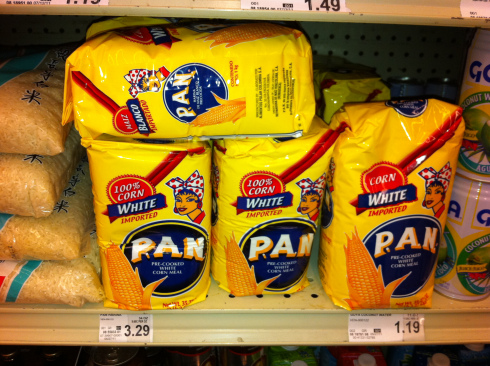
- P.A.N.: First appearing in the 1950s, Harina P.A.N. (Producto Alimenticio Nacional) was Venezuela's first brand of boiled maize flour dough. The product, still available today, is used to prepare maize-based dishes such as arepas, hallacas, and empanadas (see below). Venezuelan housewives embraced Harina P.A.N. when the precooked flour came onto the market, since it saved them from the labor-intensive task of having to pound maize in a large mortar in order to make flour. The brand became so popular that today "P.A.N." is the generic term for any cooked maize flour.
- Arepas: One of the most popular foods in Venezuela, arepas are cornmeal cakes that resemble very thick flour tortillas; they often are filled with meat, cheese and/or vegetables. Traditionally they are made from soaked, ground kernels of maize, but since the invention of P.A.N., most people use boiled maize flour. Arepas can be eaten solo as a snack, or served to accompany the main meal.

- Cachapas: Also made from corn flour, cachapas are the Venezuelan equivalent of crumpets. They can be prepared like pancakes on the grill, or wrapped in dry corn leaves and boiled. They are often sweetened and traditionally eaten with a handmade soft cheese called "queso de mano." Both arepas and cachapas are popular at roadside stands.
- Empanadas: Empanadas are crescent-shaped pastries with seasoned fillings as simple as cheese, potatoes or meat, or as elaborate as a mélange of seafood and veggies. Sweet empanadas are also made using whatever fruit is in season. Easy to bake and designed to be eaten by hand, this dish is made by folding dough around the stuffing, and it can be served as a snack or a meal, depending on how hearty the stuffing is.
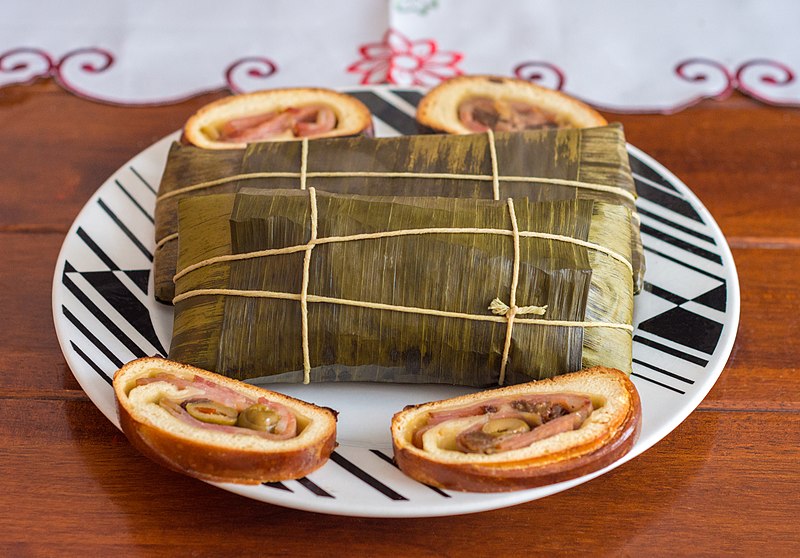
- Hallacas: Typically served around Christmas, hallacas consist of corn dough stuffed with meat and vegetables. To make it, a layer of corn dough is placed on a flat plantain leaf, then layered with meat, olives, veggies, cheese or a family's favorite combination. The little packet is folded closed, then steamed or boiled. The dish resembles a tamale wrapped in a large green plantain leaf. As with tamales, hallacas are labor intensive to make, so most prepare them only for special occasions. The plantain leaf of a hallaca is not eaten, just as the corn husk of certain tamales is not.
- Tajadas: Tajadas are sliced and fried plantains. They can be served as a side dish, part of a Pabellón Criollo plate, or a snack. They can be flavored with savory spices and salt, or sweetened with sugar and cinnamon.
- Huevos Pericos: Huevos pericos is an easy-to-make dish consisting of scrambled eggs mixed with onions, peppers and tomatoes. Cooks can customize the dish with additional ingredients such as cheese and/or meat.
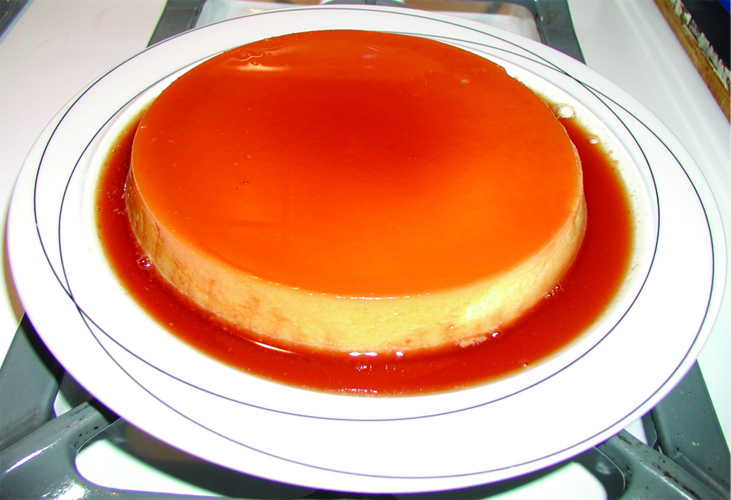
- Quesillos: A flan made from a rich egg custard topped with a sugary caramel sauce. The texture resembles jelly, and it is commonly baked with condensed milk.
- Buñuelos: Buñuelos are a dessert made from fried dough, which can be shaped as either balls or tortillas. In order to prepare these fritter-like sweet treats, dough is deep fried and adorned with sugar, cinnamon or cane syrup. They are often flattened into disks and served around the holidays.
Photo of pabellón criollo courtesy of Wilfredor.
Photo of P.A.N. courtesy of Venezuelan Cooking.
Photo of cachapas courtesy of Wilfredor.
Photo of hallacas courtesy of Wilfredor.
Photo of quesillo courtesy of Alfredojahn.
Filed under Places, Cultures & Identities
 This "beyond the book article" relates to It Would Be Night in Caracas. It originally ran in November 2019 and has been updated for the
August 2020 paperback edition.
Go to magazine.
This "beyond the book article" relates to It Would Be Night in Caracas. It originally ran in November 2019 and has been updated for the
August 2020 paperback edition.
Go to magazine.
This review is available to non-members for a limited time. For full access become a member today.
Membership Advantages
- Reviews
- "Beyond the Book" articles
- Free books to read and review (US only)
- Find books by time period, setting & theme
- Read-alike suggestions by book and author
- Book club discussions
- and much more!
-
Just $45 for 12 months or
$15 for 3 months.
- More about membership!
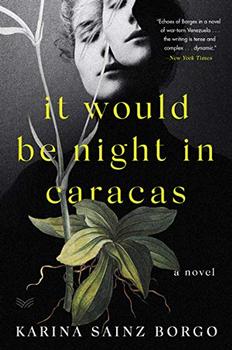
 In the novel It Would Be Night in Caracas, protagonist Adelaida endures food scarcity in Venezuela's capital city, Caracas, while recalling favorite foods from happier times. Venezuela—situated along the Caribbean Sea in South America —is home to a vibrant blend of culinary traditions. The country's cuisine has European, African, and indigenous influences that make it irresistible. As with much of Latin America, maize (corn) is a staple of the country. Other popular local crops include plantains, coconut, avocado, mango, guava, citrus, and passion fruit. A few of the nation's most prominent ingredients and dishes include the following:
In the novel It Would Be Night in Caracas, protagonist Adelaida endures food scarcity in Venezuela's capital city, Caracas, while recalling favorite foods from happier times. Venezuela—situated along the Caribbean Sea in South America —is home to a vibrant blend of culinary traditions. The country's cuisine has European, African, and indigenous influences that make it irresistible. As with much of Latin America, maize (corn) is a staple of the country. Other popular local crops include plantains, coconut, avocado, mango, guava, citrus, and passion fruit. A few of the nation's most prominent ingredients and dishes include the following:




![]() This "beyond the book article" relates to It Would Be Night in Caracas. It originally ran in November 2019 and has been updated for the
August 2020 paperback edition.
Go to magazine.
This "beyond the book article" relates to It Would Be Night in Caracas. It originally ran in November 2019 and has been updated for the
August 2020 paperback edition.
Go to magazine.





